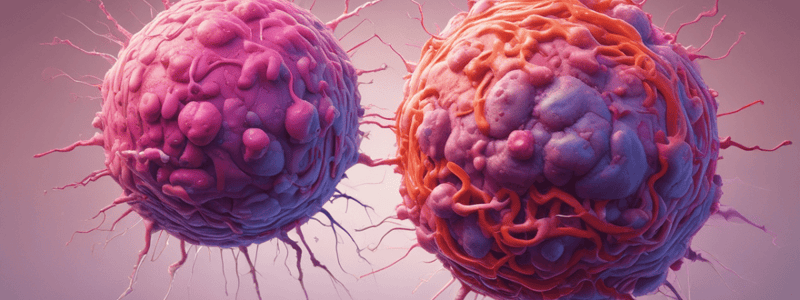Podcast
Questions and Answers
What is the most common antibiotic used for the treatment of Rickettsia typhi infection?
What is the most common antibiotic used for the treatment of Rickettsia typhi infection?
- Ceftriaxone
- Ciprofloxacin
- Doxycycline (correct)
- Azithromycin
What laboratory test is used to detect antibodies against the Rickettsia typhi pathogen?
What laboratory test is used to detect antibodies against the Rickettsia typhi pathogen?
- Lumbar puncture
- Molecular biology techniques
- Next-generation sequencing
- Serology (correct)
What is the typical onset of skin rashes in Rocky Mountain spotted fever compared to murine typhus?
What is the typical onset of skin rashes in Rocky Mountain spotted fever compared to murine typhus?
- Skin rashes appear on day 10-15 post-symptoms in Rocky Mountain spotted fever
- Skin rashes do not typically appear in Rocky Mountain spotted fever
- Skin rashes appear on day 5-10 post-symptoms in Rocky Mountain spotted fever
- Skin rashes appear on day 2-5 post-symptoms in Rocky Mountain spotted fever (correct)
What laboratory finding was observed in the case study of the 39-year-old male patient with Rickettsia typhi infection?
What laboratory finding was observed in the case study of the 39-year-old male patient with Rickettsia typhi infection?
What is the purpose of using empirical doxycycline treatment for Rickettsia typhi infection?
What is the purpose of using empirical doxycycline treatment for Rickettsia typhi infection?
What is the significance of the detection of Rickettsia typhi mcfDNA in the small series of patients?
What is the significance of the detection of Rickettsia typhi mcfDNA in the small series of patients?
How is Rickettsia typhi primarily transmitted to humans?
How is Rickettsia typhi primarily transmitted to humans?
Which of the following symptoms is NOT commonly associated with Rickettsia typhi infection?
Which of the following symptoms is NOT commonly associated with Rickettsia typhi infection?
What family does Rickettsia typhi belong to?
What family does Rickettsia typhi belong to?
When do skin rashes typically appear in Rickettsia typhi infection?
When do skin rashes typically appear in Rickettsia typhi infection?
Which type of cells do organisms of Rickettsia typhi invade once inside the human body?
Which type of cells do organisms of Rickettsia typhi invade once inside the human body?
What has recent outbreaks revealed about Rickettsia typhi in developed countries like the United States?
What has recent outbreaks revealed about Rickettsia typhi in developed countries like the United States?
Flashcards are hidden until you start studying
Study Notes
Understanding Rickettsia Typhi: An Overview
Rickettsia typhi, also known as murine typhus or endemic typhus, is a bacterium belonging to the family Rickettsiaceae. It is a zoonotic agent primarily carried by rodents, particularly murids, and transmitted through rat fleas. While historically considered rare in developed countries like the United States, recent outbreaks have highlighted the potential for epidemiological shifts in rickettsia transmission. This article explores the key aspects of Rickettsia typhi, its transmission, symptoms, diagnosis, and treatment.
Transmission
Rickettsia typhi is primarily transmitted to humans through the bite of infected fleas, specifically those feeding on rats carrying the organism. Fleas become infected when they feed on the blood of rats harboring the bacteria, ingesting the pathogen in the process. Once inside the human body through the bite, the organisms enter the circulatory system and invade various types of host cells.
Symptoms
Infection with Rickettsia typhi typically presents with the sudden onset of flu-like symptoms such as fever, chills, headache, muscle pain, joint pain, and decreased appetite. However, up to half of the patients may not experience any skin rashes, making diagnosis more challenging. Interestingly, when skin rashes do appear, they usually involve the palms of the hands and soles of the feet, appearing two to four days after the initial feverish symptoms. This progression can help differentiate murine typhus from other rickettsioses, such as Rocky Mountain spotted fever, where the onset of skin rashes is characteristic for day 2–5 post-symptoms.
Diagnosis
The diagnosis of Rickettsia typhi often relies on a combination of clinical manifestations, epidemiological history, and laboratory tests. Historically, serology has been used to detect antibodies against the pathogen, but this method can sometimes lead to delays due to its time-consuming nature. In recent years, advances in molecular biology have facilitated the detection of Rickettsia species directly from blood samples using next-generation sequencing techniques. This has led to the development of more rapid diagnostic methods that can aid in timely treatment and management of the infection.
Treatment
The most commonly used antibiotic for the treatment of Rickettsia typhi is doxycycline, which is administered as an empirical treatment until a definitive diagnosis is obtained. The use of doxycycline has been shown to significantly reduce mortality rates, particularly when administered within the first five days of the onset of symptoms.
Case Studies
One case study highlights a 39-year-old male who presented with fever, myalgias, headaches, and weight loss for ten days. After progressing to symptoms such as nuchal rigidity, photophobia, hyponatremia, thrombocytopenia, and transaminitis, a lumbar puncture revealed pleocytosis and a glucose cerebrospinal fluid/serum ratio of 0, suggesting meningoencephalitis. The patient, who was initially treated with ceftriaxone and azithromycin without improvement, received doxycycline and subsequently improved, leading to a complete resolution of symptoms and discharge home asymptomatic.
In another study, a small series of patients with Rickettsia typhi infection were identified using next-generation sequencing of microbial cell-free DNA. The detection of Rickettsia typhi mcfDNA allowed for better targeted antibiotic management and exclusion of other competing pathogens in the differential diagnosis.
Conclusion
Rickettsia typhi represents a significant public health concern, with the potential for increased prevalence and transmission in certain regions. Early recognition and appropriate management of the infection through empirical use of antibiotics like doxycycline, coupled with rapid diagnostic methods, are crucial for reducing morbidity and mortality associated with the disease.
Studying That Suits You
Use AI to generate personalized quizzes and flashcards to suit your learning preferences.




